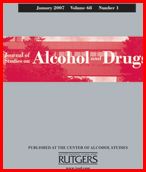To investigate the relationship among alcohol dehydrogenase-2 (ADH2) and aldehyde dehydrogenase-2 (ALDH2) genetic polymorphisms, alcohol consumption, and the susceptibility of stomach cancer in Chinese males.
Three hundred and eighty-two stomach cancer patients and 382 healthy controls from Taixing and Changshu city of Jiangsu province were enrolled in this study. ADH2 and ALDH2 genotypes were examined by PCR and denaturing high-performance liquid chromatography (DHPLC). Unconditional logistic regression was used to calculate the odds ratios (OR) and 95% confidence intervals (95% CI).
(1) In no drinkers, compared with ALDH2G/G carriers, ALDH2 G/A (OR=1.67, 95%CI: 1.01-2.78) carriers showed a significantly elevated risk of developing stomach cancer. No association was found between ADH2 genotypes and risk of stomach cancer.
(2) ALDH2 A allele carriers with cumulative amount of alcohol consumption ≥2.5 (Kg* years) were at a higher risk of developing stomach cancer compared with those with cumulative amount of alcohol consumption <2.5Kg (Kg * years) (OR=2.72, 95%CI:0.89-8.31) and ALDH2 G/G carriers with cumulative amount of alcohol consumption <2.5 (Kg* years) (OR=2.46, 95%CI=0.90-6.72) or ≥2.5 (Kg * years) (OR=2.53, 95%CI=0.86-7.49).
(3) Compared with individuals with ADH2 A/A and ALDH2 G/G genotypes, ADH2 G and ALDH2 A allele carriers were not at a high risk of developing stomach cancer, with regard to the status of alcohol consumption, and even cumulative amount of alcohol consumption ≥1.5 (Kg* years) (OR =1.65, 95%CI:0.56-4.82).
ADH2 and ALDH2 polymorphisms and alcohol drinking may not play an important role in the development of stomach cancer in Chinese males.
Read Full Article (PDF)
Three hundred and eighty-two stomach cancer patients and 382 healthy controls from Taixing and Changshu city of Jiangsu province were enrolled in this study. ADH2 and ALDH2 genotypes were examined by PCR and denaturing high-performance liquid chromatography (DHPLC). Unconditional logistic regression was used to calculate the odds ratios (OR) and 95% confidence intervals (95% CI).
(1) In no drinkers, compared with ALDH2G/G carriers, ALDH2 G/A (OR=1.67, 95%CI: 1.01-2.78) carriers showed a significantly elevated risk of developing stomach cancer. No association was found between ADH2 genotypes and risk of stomach cancer.
(2) ALDH2 A allele carriers with cumulative amount of alcohol consumption ≥2.5 (Kg* years) were at a higher risk of developing stomach cancer compared with those with cumulative amount of alcohol consumption <2.5Kg (Kg * years) (OR=2.72, 95%CI:0.89-8.31) and ALDH2 G/G carriers with cumulative amount of alcohol consumption <2.5 (Kg* years) (OR=2.46, 95%CI=0.90-6.72) or ≥2.5 (Kg * years) (OR=2.53, 95%CI=0.86-7.49).
(3) Compared with individuals with ADH2 A/A and ALDH2 G/G genotypes, ADH2 G and ALDH2 A allele carriers were not at a high risk of developing stomach cancer, with regard to the status of alcohol consumption, and even cumulative amount of alcohol consumption ≥1.5 (Kg* years) (OR =1.65, 95%CI:0.56-4.82).
ADH2 and ALDH2 polymorphisms and alcohol drinking may not play an important role in the development of stomach cancer in Chinese males.
Read Full Article (PDF)



























